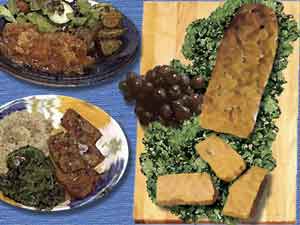Positive Health Online
Your Country

Tempeh - Soy's Super Food
by Monique N. Gilbert PhD(more info)
listed in nutrition, originally published in issue 72 - January 2002
When most people hear the word soy, they usually think of tofu and soymilk. Soon tempeh (pronounced tem-PAY) will be one of the first soy products to come to mind. It is fast becoming the most popular soy food on the market because it is highly nutritious, easy to digest, and deliciously simple to prepare. In the past five years tempeh has grown so much in popularity that it is now available in the refrigerated section of many supermarkets. Ten years ago it could only be found at health food stores and Asian food markets. While tempeh may be considered new for many, it actually has a long and extensive history dating back more than 2,000 years. Originally developed in Indonesia, it is a traditional fermented soybean product made from cracked, cooked soybeans inoculated with beneficial bacteria to give it a chewy and meaty consistency. It comes in several varieties, either 100% soybeans or soybeans combined with one or more grains like rice, millet or barley.

1. Tempeh is a nutritional super hero. It is high in protein, dietary fibre, iron, potassium, calcium and phytochemicals like isoflavones. It has been shown to lower cholesterol, high blood pressure and the risk of heart attack and stroke; reduce the risk of some cancers, like colon, breast, ovarian and prostate; ease certain menopausal symptoms; prevent and possibly even reverse the effects of osteoporosis and diabetes. To obtain these protective properties, researchers recommend consuming a minimum of 25 grams soy protein and 30-50 milligrams isoflavones daily. This works out to about 1-2 servings a day. One serving of tempeh, which is 1/2 cup (4 ounces), provides on average 19 grams soy protein, 60 milligrams isoflavones and 7 grams dietary fibre (28% RDA). Tempeh made with only soybeans has more soy protein and isoflavones than those with added grain. Whatever variety you choose, tempeh is the best source and easiest way to get lots of high quality protein, isoflavones and fibre in a minimally processed soy food. Each serving also supplies about 100 milligrams calcium (10% RDA), 550 milligrams potassium (16% RDA) and 5 milligrams iron (30% RDA).
2. Tempeh is a great choice for people who have difficulty digesting plant-based high-protein foods like beans and legumes or soy foods such as tofu. Because tempeh is a fermented soy product, its enzymes are partially broken down, making it easier to metabolize. It does not produce the unpleasant gastrointestinal discomfort and gas that some other plant-based proteins do. This fermentation process actually allows your body to assimilate and absorb tempeh's nutrients more easily. Besides being a terrific cholesterol-free easy-to-digest meat alternative, it is also ideal for people on low sodium diets. Unlike other fermented soy products, like miso which is very salty, tempeh is extremely low in sodium.
3. Tempeh has a pleasant, wonderfully unique nutty/mushroom flavour. Its rich and savoury taste and firm texture make it easy to create fantastic meals without a lot of fuss. It does not need much preparation or cooking time, making it a marvellously healthy fast food. Just add a little soy sauce or liquid hickory smoke seasoning to enhance its flavour. Then stir-fry, sauté, microwave, stew or bake it to make a variety of delightful dishes and sandwiches. To make a hearty entree in a short amount of time, all you need is tempeh, onions, mushrooms, peppers, olive oil, liquid seasoning, and some cooked brown rice or pasta. Thinly slice the tempeh. Sprinkle some soy sauce or liquid hickory (or mesquite) smoke seasoning on both sides of the slices. Slice the onions, mushrooms and peppers, and sauté in a little olive oil for a few minutes. Add the seasoned tempeh slices and sauté until lightly browned. Add salt and pepper to taste. Then place everything on a bed of brown rice or pasta, and enjoy!
So give tempeh a try. Your body and taste buds will thank you for choosing this delicious and nutritious soy food. For more information about soy, visit the
Virtues of Soy website at www.virtuesofsoy.com
Comments:
-
No Article Comments available